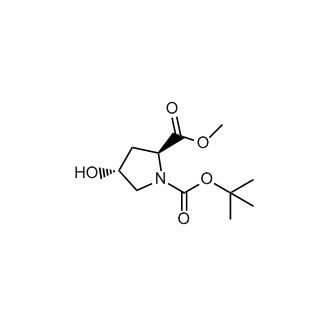trans-1-tert-Butyl 2-methyl 4-hydroxypyrrolidine-1,2-dicarboxylate
Modify Date: 2025-11-10 17:14:09

trans-1-tert-Butyl 2-methyl 4-hydroxypyrrolidine-1,2-dicarboxylate structure
|
Common Name | trans-1-tert-Butyl 2-methyl 4-hydroxypyrrolidine-1,2-dicarboxylate | ||
|---|---|---|---|---|
| CAS Number | 1145663-09-7 | Molecular Weight | 245.27 | |
| Density | N/A | Boiling Point | N/A | |
| Molecular Formula | C11H19NO5 | Melting Point | N/A | |
| MSDS | N/A | Flash Point | N/A | |
Use of trans-1-tert-Butyl 2-methyl 4-hydroxypyrrolidine-1,2-dicarboxylaterel-Boc-Hyp-OMe is the inactive isomer of Boc-Hyp-OMe (HY-65039), and can be used as an experimental control. Boc-Hyp-OMe is a non-cleavable ADC linker used in the synthesis of antibody-drug conjugates (ADCs). Boc-Hyp-OMe is also a alkyl chain-based PROTAC linker that can be used in the synthesis of PROTACs[1][2]. |
| Name | rel-Boc-Hyp-OMe |
|---|
| Description | rel-Boc-Hyp-OMe is the inactive isomer of Boc-Hyp-OMe (HY-65039), and can be used as an experimental control. Boc-Hyp-OMe is a non-cleavable ADC linker used in the synthesis of antibody-drug conjugates (ADCs). Boc-Hyp-OMe is also a alkyl chain-based PROTAC linker that can be used in the synthesis of PROTACs[1][2]. |
|---|---|
| Related Catalog | |
| References |
| Molecular Formula | C11H19NO5 |
|---|---|
| Molecular Weight | 245.27 |